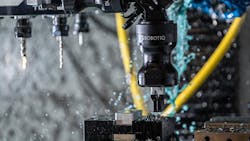While COVID-19 is putting normal manufacturing in many facilities on hold, others are leveraging their position during this pandemic by switching focus to other operations—distilleries are producing hand sanitizer and automakers are producing ventilators are two notable examples. Still, many facilities are faced with the difficulty of maintaining and switching production while keeping workers as safe as humanly possible.
Enter: cobots.
Many robotics companies, like Robotiq, are writing the playbook for facilities looking to increase worker safety without halting production. One of their strategies include the implementation of collaborative robots, or cobots.
One of the keys to the successful implementation of cobots, according to Robotiq’s initiative, is to keep it simple—predictive and repetitive. Some simple cobot jobs include:
- Pick-and-place
- Machine tending
- Packaging
Cobots are a good example of an 80-20 technology—that is, putting in 20% effort to automate 80% of a task. After that, cobot technology is adaptive enough to adjust for future improvement, but during an emergency, simplicity is important for ROI.
After the application is specified, facility decision-makers can determine if there is an existing cobot technology that can plug in to their application; custom engineering can cause delays in final product design.
Preparation is also important when incorporating cobots during the pandemic. Careful design can mitigate costs and other issues that could arise after deployment, such as timely and costly cobot repairs that could have been prevented in the design stage.
Considering cobot problems and assessing solutions before deployment requires examination of function, processing, tooling, integration, supply, training and reliability. Testing these elements can include simulations and experimentation.
The last consideration for cobot deployment in the time of the pandemic is the elimination of delays. Travel bans, remote working procedures and shipping delays can impede timely implementation. Facilities that can mitigate these delays can begin and continue production while reducing worker exposure to COVID-19.
About the Author

Marie Darty
Group Multimedia Director, Engineering & Manufacturing
Marie Darty is a digital media professional currently serving as the group multimedia director for the Manufacturing & Engineering Group at Endeavor Business Media. A graduate of Jacksonville State University, she earned her Bachelor of Arts in digital communication with a concentration in digital journalism in December 2016. In her current role, she leads the strategy and production of multimedia content, overseeing video series planning and editing. Additionally, she oversees podcast production and marketing of multimedia content.
